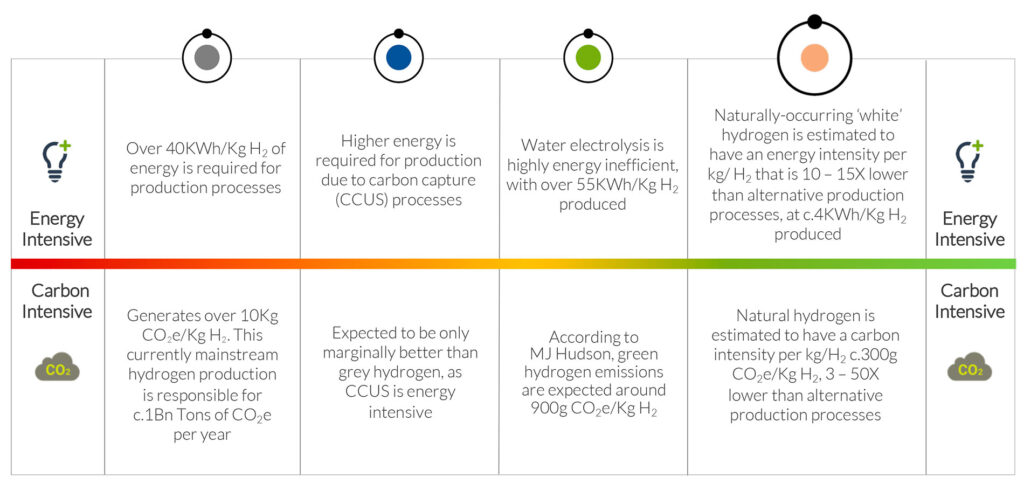Natural Hydrogen
& The Energy
Transition
![]()
Hydrogen is a critical component to drive a decarbonized energy system but not all hydrogen, however, is produced in a clean manner. Naturally occurring hydrogen has the game-changing potential to ensure a just transition by enabling food security and energy independence in developing countries
Natural Hydrogen
& The Energy
Transition
![]()
Hydrogen is a critical component to drive a decarbonized energy system but not all hydrogen, however, is produced in a clean manner. Naturally occurring hydrogen has the game-changing potential to ensure a just transition by enabling food security and energy independence in developing countries
Clean
.
Natural hydrogen can be converted to energy cleanly, without generating any CO₂ emissions when burnt
Efficient
Natural hydrogen’s high energy to mass ratio is ideal for sector with no obvious low cost fossil fuel alternatives
High growth expectations
The rise of the clean hydrogen economy could see global demand increasing seven-fold to >500 Mt H₂ p/a by 2050
Versatile
.
Natural hydrogen’s versatility both in consumption and flexibility along supply chains make it a net zero game-changer





Clean
Natural hydrogen can be converted to energy cleanly, without generating any CO₂ emissions when burnt

Efficient
Natural hydrogen’s high energy to mass ratio is ideal for sector with no obvious low cost fossil fuel alternatives

High growth expectations
The rise of the clean hydrogen economy could see global demand increasing seven-fold to >500 Mt H₂ p/a by 2050

Versatile
.Natural hydrogen’s versatility both in consumption and flexibility along supply chains make it a net zero game-changer

Central role in decarbonization strategies
Policy support for clean hydrogen is strengthening globally, with more than 30 national hydrogen strategies

 The recent interest in natural hydrogen is explained by the combination of the need for carbon-free hydrogen as a fuel for green mobility and the improvement of scientific knowledge on the formation of hydrogen in the ground
The recent interest in natural hydrogen is explained by the combination of the need for carbon-free hydrogen as a fuel for green mobility and the improvement of scientific knowledge on the formation of hydrogen in the ground 
– Isabelle Moretti,
Leading Geology Researcher

 The recent interest in natural hydrogen is explained by the combination of the need for carbon-free hydrogen as a fuel for green mobility and the improvement of scientific knowledge on the formation of hydrogen in the ground
The recent interest in natural hydrogen is explained by the combination of the need for carbon-free hydrogen as a fuel for green mobility and the improvement of scientific knowledge on the formation of hydrogen in the ground 
– Isabelle Moretti,
Leading Geology Researcher
Play video
Flowing to the surface via naturally-occurring subsurface geothermal processes in the earth’s crust, this form of hydrogen just needs to be collected
Geologists refer to this source of hydrogen as ‘natural’, ‘native’ or ‘geological’ hydrogen, but it is sometimes referred to as ‘white’ hydrogen. Read about natural hydrogen technologies here
Sources of geological “white” hydrogen are documented throughout the world, primarily above deep continental cratons in Europe, Africa, Latin America, Australia, Canada and the USA. Learn about natural hydrogen fields here
Flowing to the surface via naturally-occurring subsurface geothermal processes in the earth’s crust, this form of hydrogen just needs to be collected
Geologists refer to this source of hydrogen as ‘natural’, ‘native’ or ‘geological’ hydrogen, but it is sometimes referred to as ‘white’ hydrogen.
Read about natural hydrogen technologies here
Sources of geological white hydrogen are documented throughout the world, primarily above deep continental cratons in Europe, Africa, Latin America, Australia, Canada and the USA.
Learn about natural hydrogen fields here
 It has been said that from a geological perspective, hydrogen has been neglected, but when compared to other types of hydrogen, natural hydrogen is more environmentally friendly, cost-effective and can be considered an energy source
It has been said that from a geological perspective, hydrogen has been neglected, but when compared to other types of hydrogen, natural hydrogen is more environmentally friendly, cost-effective and can be considered an energy source 
– Pierre Levin,
Hethos CEO

 It has been said that from a geological perspective, hydrogen has been neglected, but when compared to other types of hydrogen, natural hydrogen is more environmentally friendly, cost-effective and can be considered an energy source
It has been said that from a geological perspective, hydrogen has been neglected, but when compared to other types of hydrogen, natural hydrogen is more environmentally friendly, cost-effective and can be considered an energy source 
– Pierre Levin, Hethos CEO
Why
Natural
Hydrogen?
Clean hydrogen is a critical pillar to a net zero path, helping to de-carbonize roughly 15% of global GHG emissions, and natural hydrogen is the ultimate clean and renewable hydrogen resource
 Why
Why
Natural Hydrogen
Clean hydrogen is a critical pillar to a net zero path, helping to de-carbonize roughly 15% of global GHG emissions, and natural hydrogen is the ultimate clean renewable hydrogen resource
– MJ Hudson concludes that renewable ‘white’ hydrogen has a carbon footprint lower than any other source of hydrogen, while being an energy source instead of an energy carrier, delivering 11X more energy than used in the production process












